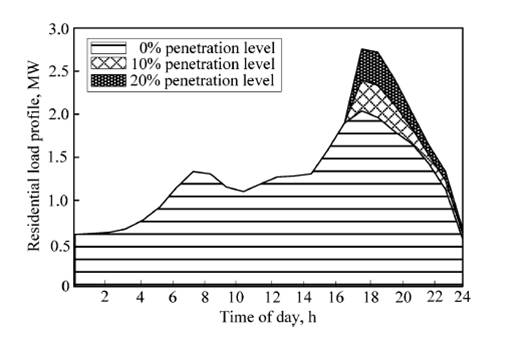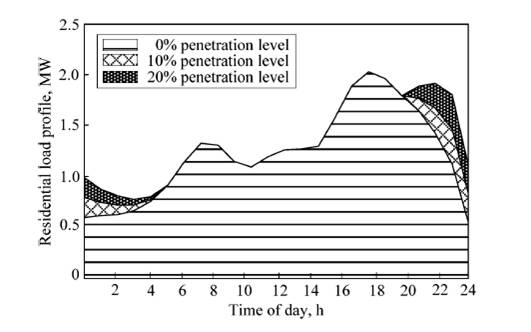Conclusions and Tariff Review
On the outset of our 12 week project we defined some aims and objectives to work towards over the course of the project
Please find listed below our aims and objectives
Conclusions
The conclusions which we come to from our work and results obtained are as under.
- EV batteries help in limiting the draw of Electrical Energy from the grid and thus make a smoother Electricity demand profile, even by maintaining the primary function of an EV, which is that of a mode of transport. The mains target of the house can be implemented in a better way with the presence of an EV. Also, by limiting the draw of power from the grid, the cost of the household for utility bills is lowered. Also, the power demand for the evening peak is limited by the EV battery and the power draw curve from the grid is fairly smoothened.
- Stand alone PV can be the solution to most Zero Carbon Homes.We have concluded from our modelling and research that PV alone can be the solution to most zero carbon homes in Scotland. The roof design of zero carbon homes potentially have enough area to accommodate enough PV panels which are required for the homes to be net zero carbon. Whenever an EV is integrated into it, the required area of PV panel increases significantly and the zero carbon home is unable to accommodate that. Therefore, in such cases, other forms of renewable energy supply need to be integrated.
- Stand alone PV is not the answer to Zero Carbon Home and EV integration Whenever an EV is integrated into it, the required area of PV panel increases significantly and the zero carbon home is unable to accommodate that. Therefore, in such cases, other forms of renewable energy supply need to be integrated along with the PV and the net effect needs to be analysed.
- Presently a time based peak and off-peak variable electricity rate tariff structure will help Distribution Network Operators have a greater control over the increase in load demand caused by EV penetration into the domestic household demand.This will help shift the additional load which will be caused by the introduction of EVs to the night off peak period. This will help in smoothing the total electricity demand curve over the whole 24 hour period each day.
- Present Feed-In-Tariff rates are not very encouraging to the customers to opt for zero carbon homes. The payback periods for the zero carbon homes is too long at the present rates. The Feed-In-Tariff rates would need to be significantly increased to encourage people to opt for zero carbon homes.
- The present assumption made by the DNOs of a 50-50 ratio between the energy produced by PV panels and that consumed by the home is not a very good one. People are losing large amounts of money, even at the present Feed-In-Tariff rates. Vice-versa, this also means that DNOs would have to spend out a lot more money if the present assumption is changed and would need to see if it still economically viable.
Why Need New Tariffs?
Introduction of Electric Vehicles (EVs) in the domestic sector will cause the load to rise amongst domestic consumers. This will affect the Low Voltage power distribution system as it will imply higher loads for houses. The underground cables supplying these houses will need to be revamped according to the penetration of EVs into the domestic sector. One important consideration to be made is to try to balance the load curve and flatten the power demand curve for the whole day.
There are three types of possible Tariff systems by which the domestic consumers could be billed
- Uncontrolled Charging
- Uncontrolled Off-peak charging
- Smart Charging
Uncontrolled Charging
This is a scenario in which Distribution Network Operators (DNOs) will have no control over when its consumers can charge their EVs and it will be left totally to the choice of the consumer. Uncontrolled charging charging will introduce increased instability in the existing power network as most people will want to charge their EVs at the evening peak, when the demand for electricity is maximum. Most people will prefer to return home from work and straight away plug in their EV into the grid, as this is the time of the day when the battery of the EV will have the minimum SOC.This will cause a huge increase in demand at this time and will be increasingly difficult to meet.
Uncontrolled Offpeak Charging
This is a scenario in which DNOs will be able to control the demand for electricity by introducing different prices for electricity consumption by during the day. This will encourage consumers to charge their EVs at the time when the cost of electricity is the cheapest. The DNOs will be able to fix this according to their suitability. It will be mainly a period in the night to the morning when the electricity demand is least in the network. This will also cause the electricity demand curve for the whole day to smoothen out. This will enable DNOs to have a better control over the network and not worry about any unwanted scenarios where the network becomes unstable.
Smart Charging
Smart charging employs an active management system with a hierarchical control structure. All of the elements connected to the grid are monitored continuously, making efficient use of available energy resources and monitoring grid restrictions,voltage and frequency fluctuations (Lopes et al, 2009).
This is a future scenario when DNOs will have complete control over the electricity demand over the network. The DNOs will have access to domestic loads and will be able to decide when they would like to supply a particular load, as per the demand and supply matching the that particular moment in time. This will particularly help in bringing increased stability in the network and further smoothen the electricity demand curve over the day. However, this will still mean shifting most of the load to the off peak period in the night, when the electricity demand is the least.
Below are three figures which show how the different Tariff schemes will affect the electricity network.

Effect of uncontrolled charging on the Electricity Network (Qian et al., May 2011)

Effect of uncontrolled Off-Peak charging on the Electricity Network (Qian et al., May 2011)

Effect of Smart Charging on the Electricity Network (Qian et al., May 2011)
Recommendations
Tariff recommendations to Distribution Network Operators (DNOs):
- A time based variable rate of electricity is the recommended structure for DNOs while the EV market is expanding. This will encourage consumers to charge their EVs at the time when the price of electricity is the cheapest and will give a better control over the network to DNOs.
- Uncontrolled charging and non-time based tariff structures will reduce the control of DNOs of the Electricity Network and will further exaggerate the existing spikes in the demand trends.
- Smart metering based smart charging tariff systems should be introduced in the future. This will not only help the V2H technology but also V2G technology.
Environmental Impacts
EVs presently use Lithium-ion batteries. These batteries themselves have a significant environmental impact. Some of the major impacts identified by us are as under.
- Lithium-ion batteries have a large impact on metal depletion. The primary material responsible for this is the lithium iron phosphate , but there is also some impact on the metal resource depletion from the use of an electronic component such as a transistor.
- The mining of Lithium is a carbon intensive process and this adds to the environmental impacts of using Lithium-ion batteries in EVs.
- The production of Lithium-ion batteries is an energy intensive process. A huge amount of energy goes behind the manufacturing of these batteries.
- The option of using Lithium-ion batteries can see us through for about a 100 years, but further than that, other types of batteries will have to be developed, as the Lithium deposits would be exhausted by then
McManus MC.Environmental consequences of the use of batteries in low carbon systems: The impact of battery production. Appl Energy (2012), doi: 10.1016/j.apenergy.2011.12.062